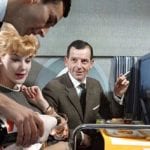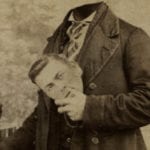 Weird Stuff
Weird Stuff  Weird Stuff
Weird Stuff  Our World
Our World 10 Ways Your Christmas Tree Is More Lit Than You Think
 Movies and TV
Movies and TV The 10 Coolest Stars to Set Sail on The Love Boat
 History
History 10 Things You Didn’t Know About the American National Anthem
 Technology
Technology Top 10 Everyday Tech Buzzwords That Hide a Darker Past
 Humans
Humans 10 Everyday Human Behaviors That Are Actually Survival Instincts
 Animals
Animals 10 Animals That Humiliated and Harmed Historical Leaders
 History
History 10 Most Influential Protests in Modern History
 Creepy
Creepy 10 More Representations of Death from Myth, Legend, and Folktale
 Technology
Technology 10 Scientific Breakthroughs of 2025 That’ll Change Everything
 Weird Stuff
Weird Stuff Ten Bizarre Facts About The Doge Meme
 Our World
Our World 10 Ways Your Christmas Tree Is More Lit Than You Think
 Movies and TV
Movies and TV The 10 Coolest Stars to Set Sail on The Love Boat
Who's Behind Listverse?

Jamie Frater
Head Editor
Jamie founded Listverse due to an insatiable desire to share fascinating, obscure, and bizarre facts. He has been a guest speaker on numerous national radio and television stations and is a five time published author.
More About Us History
History 10 Things You Didn’t Know About the American National Anthem
 Technology
Technology Top 10 Everyday Tech Buzzwords That Hide a Darker Past
 Humans
Humans 10 Everyday Human Behaviors That Are Actually Survival Instincts
 Animals
Animals 10 Animals That Humiliated and Harmed Historical Leaders
 History
History 10 Most Influential Protests in Modern History
 Creepy
Creepy 10 More Representations of Death from Myth, Legend, and Folktale
 Technology
Technology 10 Scientific Breakthroughs of 2025 That’ll Change Everything
10 Outlandish Early Flying Machines
Early aviation history is fascinating. Although many airplanes were successful, there was not a clear consensus as to how the best airplane should be designed. Because of this, aviation pioneers tried a variety of strange concepts in an attempt to start the next big aviation revolution. This experimental mentality transferred over into World War I. The use of airplanes in warfare had not been concretely established, and a variety of airplane types took to the skies during the war. This list is about those interesting and outlandish flying machines in the period before World War II and the dawn of modern aviation.
10Armstrong Whitworth Ape

Experimental aircraft are always expensive investments. Most are built for only one specific flight regime or test only one idea. In the early days of aviation, this caused a big problem, since most test aircraft were woefully bad airframes that completely failed even at testing concepts. Faced with the problems of funding and personnel, the British Royal Aircraft Establishment began to look for new ways to test aerodynamics without having to build a whole new airplane for every single question they had. The RAE issued a request to various airplane manufacturers to build an “infinitely” adjustable airplane that would answers all the questions about aerodynamics.
Armstrong Whitworth jumped at the opportunity. During World War I, Armstrong Whiteworth had provided a variety of airplane types for the RAF, but with the postwar defense cuts, he was having a hard time securing contracts. To meet the RAE requirement, they designed the Ape, an infinitely adjustable biplane. The Ape truly lived up to its requirement. Engineers could add bays to the fuselage or take them away, making it longer or shorter. The wings could be adjusted to have varying degrees of dihedral or even be swept back. Oddly, the tail section moved as one piece, allowing it to be angled up or down during flight, depending on what needed to be tested. Shockingly enough, these features made the Ape an extremely ugly plane.
Although the options met the promise of an infinitely adjustable airplane, the Ape was saddled with a woefully underpowered engine. With a top speed of only 145 kilometers (90 mi) per hour, the Ape could only experiment in slow flight regimes, which was unhelpful for developing a new generation of fighter planes. Armstrong Whitworth swapped in a more powerful engine for the second aircraft, but the RAE requested that extra gadgets be put in the airplane, nullifying the performance advantages of the new engine. After a few months of testing, it became clear that the Ape was not very useful in exploring the mysteries of aerodynamics, and the project fell out of favor without providing any technological advances.
9Sikorsky Ilya Muromets

Say what you will about Russian engineering, but history has shown that when it comes to making big military airplanes, the Russians sure know how to do it. The Ilya Muromets was the biggest airplane in its day, one that pioneered many of the commonplace aviation concepts that we take for granted today. Originally, Igor Sikorsky designed the Muromets as a large, four-engine passenger airplane that would revolutionize air travel. When it first flew in 1913, it had a host of features that were never seen before. For the first time, the passenger cabin was insulated with electricity and heat coming from a small, wind-powered turbine. The Muromets had a small bedroom in the back equipped with the world’s first airborne toilet.
Initial flights of the giant biplane were a great success. The Muromets flew all over Imperial Russia as a propaganda tool. Sikorsky’s dream had come true. However, before passenger flights started in earnest, World War I began, and the Muromets entered service as a heavy bomber. The transition was an obvious one. With a range and payload far greater than contemporary bombers, the Muromets easily outclassed most other warplanes. Sikorsky fitted his biplane with defensive machine guns and a crude bombsight. Training was difficult for crews, since nobody had flown an airplane so big. After a rough transition period, a Muromets squadron was formed, becoming the first four-engine bomber squadron and the first dedicated strategic bombing unit.
In service, the Muromets was an extremely effective weapon. Bombing raids were conducted throughout the war, and it was rumored that a Muromets bombing raid would make a ground position useless for weeks. The sturdy design of the bomber also made it nearly impossible to shoot down, creating a mythology rivaling its namesake (an epic hero from Russian folktales). Muromets crews fought throughout the war and even served in the following Russian civil war.
Looking back, the importance of the Ilya Muromets cannot be overstated. Not only did it innovate new ideas in commercial aviation, it also proved that strategic bombing was a practical and worthwhile tactic. In the next world war, the concepts pioneered by the Muromets would turn the tide of the conflict.
8Blackburn Blackburd

Naval aviation was just in its infancy in World War I. While most other parts of air warfare were still developing, naval aviation suffered severe technological limitations from the start. No country had purpose-built aircraft carriers, so all were instead forced to rely on ships modified to carry airplanes. Most large naval airplanes were underpowered, and no ships were long enough for a sufficiently long landing strip. Because of this, the combat profile for a large naval torpedo bomber was to take off from the ship only in a strong headwind, fly to the target, conduct the raid, and then either return to the ship or find a land base. Returning was tricky. Pilots would have to ditch their airplanes in the water and hope that they were recovered. Generally, this type of flight plan was avoided.
This was the idea behind the Blackburn Blackburd, which was intended to launch British naval aviation into the next generation. As the war progressed, naval commanders were concerned that current torpedo bombers could only carry small warheads. The Blackburd was designed to carry the Mark VII torpedo, one of the biggest in the fleet. Blackburn’s design was as simple as possible, so it was shaped like a slab-sided box with no tapered surfaces. The Blackburd was ugly but functional. The large wings could fold back to fit in a ship’s hangar, and it could carry the torpedo.
Unfortunately for the Blackburd pilots, the plane was designed to ditch in the water next to its home ship. On takeoff, the landing gear was jettisoned in the water, forcing the pilot to commit to the eventual water landing. If the landing was completed, the hapless pilot would have to wait by his plane, hoping the ship would recover him and his bomber before they both sank underwater. When the first Blackburd was delivered, it crashed on the first test flight. With the proposed engine and a torpedo, the plane was simply too heavy to control and flew just like you would expect from an airplane shaped like a box. The Navy was disappointed in the design and rejected it, saving countless pilots from the unenviable fate of having to purposefully crash-land into the water.
7Blackburn TB

Zeppelins were a key aspect of strategic warfare in World War I. Before high-performance interceptors became commonplace, zeppelins could bomb nearly unmolested over their target. The large balloons were flying fortresses. German commanders attacked England with zeppelins at the beginning of the war, and spooked Admiralty commanders enough to start looking for airplanes specifically designed to combat the “zeppelin menace.” Blackburn responded to the request and created the most specialized airplane in history. The unfortunately named TB was a twin-hulled, long-endurance, fire-dart-armed, zeppelin-intercepting float plane.
To give the airplane long endurance, engineers decided on a twin-engine layout, but instead of fitting both engines in one fuselage, they made the odd decision to join two separate fuselages side by side. In the days before radio, this gave the crew members no way to communicate with each other besides hand signals. Instead of using guns to take down the zeppelins, TB crews would have used the Ranken dart. This hand-dropped explosive was specifically designed to pierce the skin of a zeppelin. Once inside, three spring arms held the dart in place, and it ignited a small charge into the gas chambers of the balloon. The gas would ignite, sending the zeppelin crashing to the ground. Although the dart may seem outlandish, it actually was effective against German balloons and was critical until airborne cannons and incendiary rounds entered service.
The only problem with the Ranken darts was that a pilot had to be above the zeppelin to use them. This was a big challenge for the TB. Its weak engines could barely give the airplane thrust, and its maximum altitude was well below the service ceiling of a zeppelin. The TB was also extremely slow and could have been outrun by German airships. Without a good service altitude, the TB was useless, and the nine prototypes never saw combat service. Admiralty commanders moved on to other ideas.
6Caproni Ca.60

Gianni Caproni was a pioneer of aviation. During World War I, he constructed several biplanes for the Italian Air Force, specifically large, multi-engine bomber planes. As the war ended, Caproni focused on his dream of creating a large passenger plane. Since before the war, Caproni had promised a 100-passenger airplane that would carry people across the Atlantic. To make the airplane as safe as possible, Caproni decided to go with a configuration of nine wings and eight engines. The Ca.60 ended up being a cross between a seaplane and houseboat.
After a couple of years of design and manufacturing, the Ca.60 was finally ready to fly. It was powered by the exceptional Liberty 12 engines and had a wing area of over 800 square meters (8,500 ft2). Caproni received tremendous support from the press, government officials, and even the United States ambassador to Italy, who considered the seaplane the shape of things to come. Testing began at Lake Maggiore in 1921, but the first test flights were met with bad weather and problems with the lower wings. Eventually, on March 2, the Ca.60 was loaded with ballast and briefly took to the air. The plane handled fine and was able to splash down successfully after a brief flight.
On March 4, a second test flight was attempted. As the Ca.60 accelerated to its top speed, it refused to lift more than a few feet above the water. Suddenly, the huge plane nose-dived into the water, instantly disintegrating. Fortunately, the test pilot survived and only suffered minor injuries, but the Ca.60 was wrecked.
Nobody is quite sure what happened. Some sources say that the pilot stalled the airplane, while others say that he crashed trying to avoid a tugboat on the lake. The most reasonable explanation is that the ballast in the fuselage broke free of its restraints and unbalanced the airplane. Whatever the case, Ca.60 was stored in its hangar, where it was later destroyed by a mysterious fire. Caproni never tried to rebuild his project. The dream of trans-Atlantic flight would have to wait.
5Christmas Bullet

William Whitney Christmas was a medical doctor who decided he needed to break into the aviation business. In the early days of aviation, this sort of career change was not unheard of, but most people who decided to work in aviation had some sort of training. Dr. Christmas had absolutely no understanding of aerospace principles and was also a compulsive liar. He claimed to have built his own airplane in 1908 and 1909, the first of which of was supposedly lost in a mysterious fire. Although only the 1909 design was confirmed as being manufactured, Dr. Christmas raised enough money to found his own aerospace company.
At the time, airplanes needed extensive struts and wires to keep the wings attached to the fuselage and stable. Dr. Christmas believed that the wings of an airplane should be left free and went about proposing biplanes without any struts. In 1915, he claimed that such airplanes would be the largest ever made and that European powers had already purchased several of his “Battle-Cruisers.” Despite this claim, Dr. Christmas went about building a small fighter prototype for the Air Force. Named the Christmas Bullet, the little airplane was expected to reach a top speed of 317 kilometers (197 mi) per hour, faster than contemporary airplanes. By promising a New York senator that the airplane would be used to kidnap Kaiser Wilhelm II, Dr. Christmas pulled enough strings to borrow a prototype Liberty 6 engine from the Army, which was meant only for ground testing. Dr. Christmas built the Bullet around this prototype engine and prepared for a test flight.
World War I had ended by this point, but Dr. Christmas still had his engine and arranged for a test pilot to take the first flight. Almost immediately after takeoff, the wings peeled off the airplane, sending it careening into the ground. The pilot died, and the Liberty 6 engine was destroyed. Undeterred, Dr. Christmas built a second prototype and convinced the Army to supply him with a propeller. He had not yet disclosed the destruction of the Liberty 6 engine.
After several media appearances, the second prototype was flown with the same results as the first. With two pilots dead from his airplane, Dr. Christmas finally gave up but not before getting the Army to buy the patent off him for $100,000. While he never had a successful flight, Dr. Christmas designed outlandish airplanes for the rest of his life, all the time without a shred of knowledge about aerospace engineering. Fortunately, none of his other designs were tested.
4AEA Cygnet

When the Wright Brothers launched the era of powered aviation in 1903, not everybody agreed their choice of a powered biplane was ideal—or even practical. Among these detractors was Alexander Graham Bell, famous inventor of the telephone. Bell believed that the Wright brothers had come up with an interesting design but that it was not versatile or practical enough to make powered flight commonplace. To experiment with new (and supposedly better) ideas, Bell founded the Aerial Experimental Association (AEA), a Canadian-American group of young men interested in aviation.
Chief among Bell’s concepts was the tetrahedral box kite. Bell believed that a good airplane would not use a Wright-style airfoil but rather a huge bank of tetrahedral cells stacked on top of each other. The AEA built and tested a large box kite with this principle. In 1907, it was towed behind a motorboat with an AEA test pilot at the controls. The ungainly kite reached a height of 50 meters (170 ft). Convinced the design was worth pursuing, the AEA redesigned the kite to house an engine, creating the Cygnet. With more than 3,000 cells, the Cygnet was a strange and intimidating sight, but the AEA believed it was the future of aviation.
The first test flights did not go ahead as planned. The Cygnet stubbornly refused to leave the ground. By adding an engine, the AEA had completely nullified the lift properties of the tetrahedral structure. After countless tests, Bell decided that the AEA should conduct more research on biplane flight.
Moving their attention away from the Cygnet, the AEA built the Silver Dart biplane, using the Cygnet engine for power. When the Silver Dart proved airworthy, the AEA restarted testing on the Cygnet. Eventually, the Cygnet took flight but only got 1 meter (2 ft) off the ground. On the next test flight, the tetrahedral structure collapsed, leaving the plane irreparably damaged. With this failure, Bell and AEA realized that the Cygnet was an aviation dead end and decided to move on to more practical designs.
3Philips Multiplane

As mentioned above, not everybody at the dawn of aviation agreed with or accepted the Wright Brothers’ design of the airplane. Horatio Philips believed that the ideal airplane would have a large number of wings that could generate lift together. He began working on this project before the Wright Brothers. Philips’s first step was to create his own wind tunnel, which ended up being one of the most powerful and efficient of his day. This allowed Philips to test a variety of airfoil designs and decide which ones were worth pursuing.
In 1891, Philips filed for one of the first patents describing a modern wing shape and went about designing an airplane. With wind tunnel tests demonstrating that many thin, high–aspect ratio wings would give enough lift, Philips made an unmanned aircraft with a set of 50 wings. Mounted on an arm that would sweep the airplane on a circular track, Philips discovered that this arrangement could lift about 180 kilograms (400 lb). The airplane was very unstable even on the ground, but Philips was convinced that his Multiplane design was the way forward.
It was not until 1904 that the first manned Multiplane was ready for testing. Powered by an unusual coal engine, the 1904 airplane had 20 wings stacked on top of each other. On the test flight, the plane took to the air for 15 meters (50 ft) before settling back to the ground.
Undeterred, Philips went about making a new airplane. This time, his Multiplane had 200 wings and looked more like a box than an airplane. During the 1907 test flight, the new Multiplane took to the air and flew for 150 meters (500 ft), completing the first powered flight in the United Kingdom. Although the flight was a historical success, the 1907 Multiplane was still plagued with stability issues and was nearly impossible to control in flight. Even though his airplanes did not work, Philips’s research on airfoils was extremely influential on other aviation pioneers.
2Seddon Mayfly

Looking more like a piece of modern installation art than an actual airplane, the Seddon Mayfly was designed to meet a Daily Mail competition for the first airplane to fly between Manchester and London. Caught up in the excitement of aviation, sailor John W. Seddon built a paper model of what he believed was the ideal airplane design. Seddon took leave from the Royal Navy and enlisted the help of a fellow engineer to design an airplane based off his paper model.
The Mayfly actually had a fairly conventional layout. It used two huge banks of curved biplane wings joined in the middle by the cockpit and engines. What gives the airplane such an odd look is the bracing. Seddon believed that using high-tensile metal hoops to brace the wings would be better than traditional wood and wire bracing. When the airplane was completed, it had used 610 meters (2,000 ft) of tubing. Due to this unusual design element, the six-seat Mayfly was the biggest and heaviest airplane in the world. English aviators looked forward to its flight with great optimism. If it flew, the Mayfly would give English aviators a significant lead on their American and European competitors.
The Mayfly never took to the air. Although it was an impressive machine, the lift of the wings was not enough to get the bulky metal structure off the ground. During its first high-speed ground test, a wheel collapsed, damaging the airframe. Seddon began repairs but was called back to the Navy. With Seddon gone, nobody took interest in the Mayfly, and it languished in a hangar bay. Eventually, the airplane met an ignominious end as it was torn apart by souvenir hunters.
1Flettner Airplane

In the 1830s, chemist H.G. Magnus discovered that when a cylinder or sphere is rotating in a fluid (like air or water) it generates a sideways force. This is why if you drop a spinning sphere from a large height, it will begin to curve away from a straight downward motion. If applied precisely, the Magnus principle can also be used to generate lift. A cylinder and sphere spinning at certain rates and directions will generate a force analogous to lift. In fact, given the right conditions, this lift will be greater than that of a normal wing. German engineer Anton Flettner believed that this effect could be used to make airplanes.
Flettner already had success with the Magnus effect by applying it to a boat. Replacing the propeller screws with a cylinder could power the ship, though not much more than a standard propeller. Using the research from his boat, Flettner began designing an airplane. The aptly named Flettner airplane did away with wings and replaced them with big metal cylinders. Two engines were fitted to the airplane, one to drive a standard airscrew and another to spin the cylinders. Theoretically, the airplane should have flown, but no record exists of whether it made a test flight. Modern aviation enthusiasts have built their own remote-controlled versions of the Flettner airplane. These versions do fly, proving that the principles behind the airplane were at least sound.
Records of the test are lost to history, but whatever the outcome, Flettner decided to shift focus to helicopters. During World War II, he designed helicopters for the German Luftwaffe. Although they did not see mass production, the Flettner designs were important precursors to modern helicopters. After the war, Flettner designed helicopters for the United States, including the successful
I am a physics students who likes to write on the side. Check out my other articles on this site and my personal blog.






